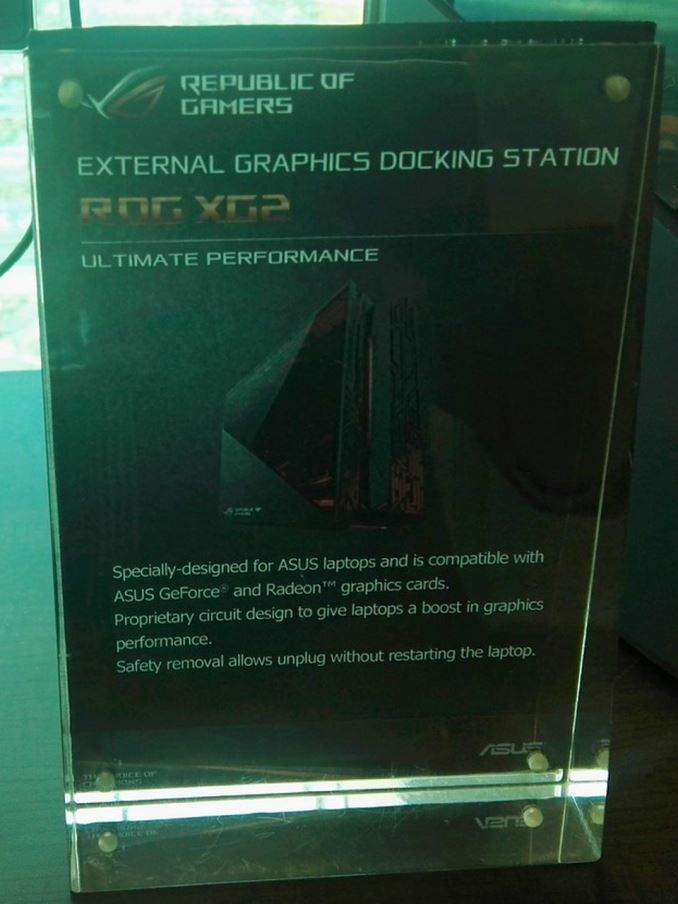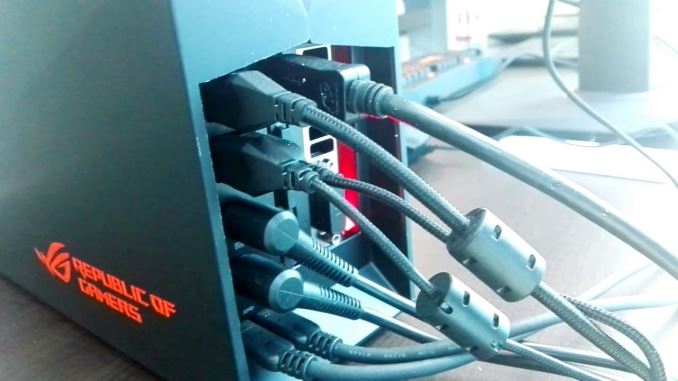ASUS Booth Tour at CES 2016: 10G Switches, External GPU Dock, USB-C Monitor and more
by Ian Cutress on January 19, 2016 9:00 AM ESTDuring CES this year it was clear that one of the overriding themes was external graphics solutions. Intel’s Thunderbolt line of ICs has historically been the source of musings, and we saw first and second generation Thunderbolt enclosures being demonstrated at previous events. Several reasons were given for them not being released, including limited bandwidth and the ability to hot-plug were cited as well as other factors. Third generation Thunderbolt offers up to 40 Gbps of bandwidth over an active cable, and it sounds like some implementations are now supporting hotplug, meaning that we will see some entering the market. However, ASUS’ implementation is considerably different.
The External GPU Dock, over Type-C
If we look at several items on the market, namely the newly announced GX700 laptop from ASUS with a water-cooled graphics card, or the MSI GS30 series of laptops, or even something like the MSI AIO with an external graphics card - the trend is to pass the PCIe lanes through an interface as if the connection is transparent to the PC. This has a variety of limitations such as hot plug probably won’t be enabled and it requires a reboot to switch between the graphics, but it does provide a stop-gap solution for sure.
The external GPU dock on display from ASUS is a little different again to the laptops and AIO mentioned in the previous paragraph, by taking the PCIe lanes and passing the data over a Type-C interface. Using a proprietary IC, ASUS is able to carry 32 Gbps of data over a passive Type-C cable (note, Thunderbolt 3 is limited to 20 Gbps over passive) to a dock that can decode the data. That being said, there were two data cables going from the dock to the laptop, making me think that this is actually two lots of 20Gbps maximum and the IC logic is there to reconstruct the bits from different PCIe lane data streams.
The enclosure on display we are told is near final, and uses the same Mayan pattern-like design as ASUS’ current range of small gaming PCs. The dock is designed to take any serious single GPU card up to 350W, and because the data comes over PCIe, the card can also be overclocked as if it was directly attached as in a normal desktop. Here’s a video:
So there are a few things worth mentioning. The external dock does need an external monitor to run. Because the dock requires ASUS proprietary technology and only ASUS laptops will have it, we are told that the laptops will carry a mini-DisplayPort input connection, meaning that the GPU can be hooked straight back into the laptop if necessary. If the dock has sufficient power, it can also be used to charge the laptop via a USB-C charging connector as well, meaning that the laptop does not need to be attached to power when this is occurring.
External graphics is a minefield of coping with errors. If the dock is removed, the system should crash, but the idea here is that a user can simply bring their laptop home and start doing powerful gaming. ASUS is saying that their solution can survive a hot-plug event, merely by causing the program that needs the GPU to close – but each GPU will need to be validated in this environment separately as time goes on. The other element is that if this ends up purely for ASUS laptops, there needs to be a few models (both gaming and business oriented) that can support it. No doubt we will see more as time goes on.













50 Comments
View All Comments
randomhkkid - Tuesday, January 19, 2016 - link
The ROG GX700 dock only contains radiators and pumps, the 980 laptop gpu is housed in the laptop itself. http://core0.staticworld.net/images/article/2015/1...hechacker1 - Tuesday, January 19, 2016 - link
That's a good start for a 10G switch, but it really needs more 10G ports to be useful. I deploy 10G all the time for my job, and we use the Intel X520, which is a generation behind, but stable as a rock and supported everywhere. It also can be found for relatively cheap (sometimes $250). At those prices it almost makes sense to build your own "switch" by just using 10G cards and directly connecting where you need it. I know in my environment I really only need 10G to my NAS, and then 10G to the workstation for media / VMs.BrokenCrayons - Tuesday, January 19, 2016 - link
A Cherry Trail phone with 4GB of RAM and 256GB of storage for $350 sounds great. Now if only a certain software company that makes operating systems would be kind enough to stop it with the silly pricing that keeps budget laptops with Cherry Trail processors chained to half that much RAM and 1/8th of the storage. >.<Pissedoffyouth - Tuesday, January 19, 2016 - link
Why the hell do they have to make a retarded version of the zenphone with bigger battery. Give me the atom version with 5000mah battery and I'll pay good money for itcfineman - Tuesday, January 19, 2016 - link
So when is that gsync monitor coming out? Seems like's it's been vaporware for a while... are they trying to work out the of the QC issues Acer has been dealing with or...???CaedenV - Wednesday, January 20, 2016 - link
@Ian, I am also excited that 10/t is finally coming to the consumer market! I have a NAS, and constantly have to move around ISOs and uncompressed video files/projects between my main PC and my NAS. Thankfully I get a solid 98-102MB/s... but the idea of being able to get 980MB-1GB/s sounds too good to be true! I mean, a Windows ISO would take a mere 10 secconds to transfer... heck at those speeds just use the NAS like a local HDD and write straight to and from it without ever transferring to a local disc!Thankfully for me though, the rest of my family is quite alright with gigabit Ethernet and WiFi, so having only 2 10Gb/s connections is not a bad limitation for me. They need to bring the price down a bit more before I'll bite though. $200 for an unmanaged switch with 2 10Gb/s ports and 4 1Gb/s ports, and $75-100 for each card. Still, I could see it being something when I do my next big build in a few short years.
... now if only they can do something about my 25mbps internet conneciton and 5mbps uplink...
sor - Wednesday, January 20, 2016 - link
The switches are underwhelming. We've had affordable switches with a few 10g + a bunch of 1g for awhile.10g baseT has been a pretty epic failure so far. I managed to find a 48 port Dell 3 years ago, pretty much the only full 10G baseT available, and it was so power hungry that it couldn't keep more than 24 ports running at once. They took it back, then discontinued the line. SFP+ and twinax for cheap copper interconnects worked much better.
merikafyeah - Wednesday, January 20, 2016 - link
10GbaseT is actually a mandatory part of the Thunderbolt 3 spec, so a TB3 (USB Type-C) switch could finally bring affordable 1GB+/s transfers to consumers.noeldillabough - Wednesday, January 20, 2016 - link
Will 10G work reliably over Cat6/6a? Or do we need to use Cat7/8 etc?sor - Thursday, January 21, 2016 - link
6a is the standard for 10g baseT. There are other types floating around like 6e, 7, 7a, etc, but none are standards based, mostly marketing.